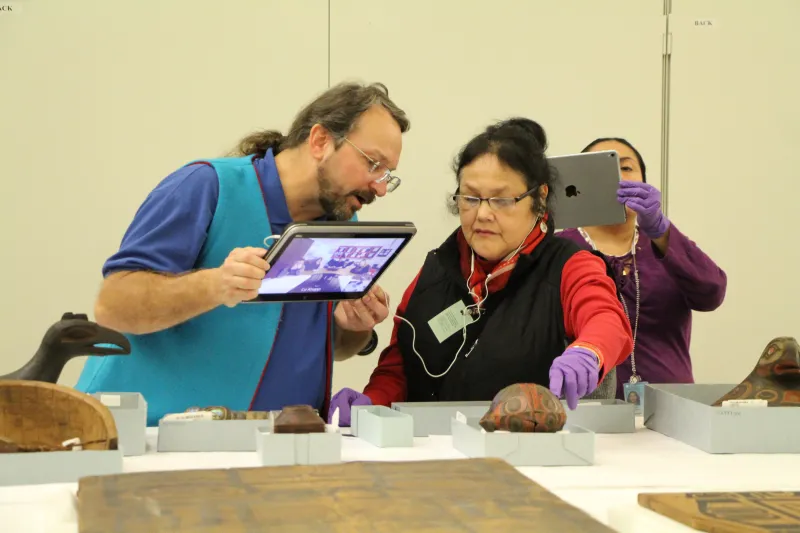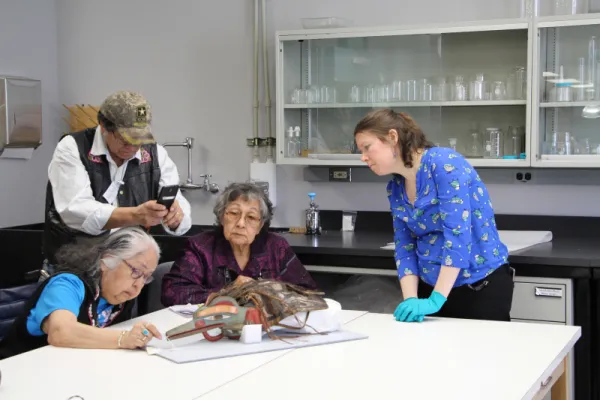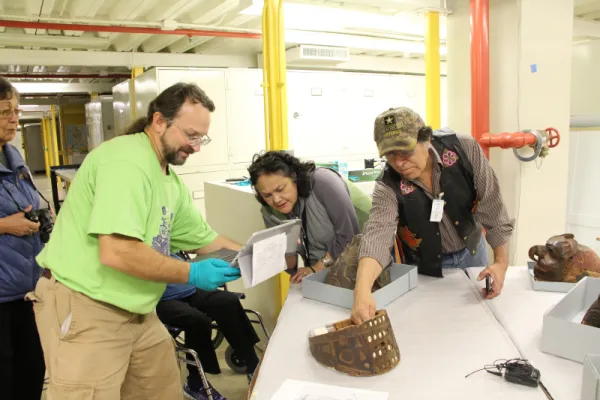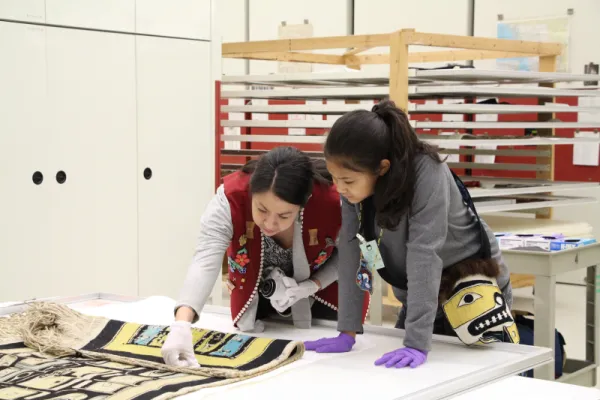
Search

News from Recovering Voices
Video Calls and Virtual Realities: Tlingit Communities Connect Through Technology
By: Theresa Mitchell
05/24/2017

Technology, especially digital media, has created new avenues for people to share with one another across long distances. During a two week Community Research Visit in March, Tlingit researchers employed technology to open their visit to their communities in Southeast Alaska. Spending one week of their two-week visit at the collection facilities of the National Museum of the American Indian (NMAI) and the other at the National Museum of Natural History (NMNH), the group diversified their understanding of Tlingit history and culture by studying a variety of their material heritage. While the individuals in the group came from different villages, had different backgrounds, and brought with them different interests, they were united by their commitment to increasing and spreading Tlingit language and knowledge. During one discussion, members of the group expressed that the reason they were excited about their research trip was precisely because it was an opportunity for them to share, and continue sharing, their language and culture. Throughout the visit, researchers used FaceTime calls, video conferences, digital photographs, and a virtual reality camera to open up the collections to those back home. Using new technology not only enriched the experience for the group, but gave Recovering Voices and other Smithsonian staff ideas about how to better utilize technology in the future.

The group's desire to share was exemplified one afternoon in particular, when there were three separate video calls taking place at once. With two group members at the hotel due to illness and two teachers planning to call their classes in Alaska, there were a lot of people to connect with. Using an iPad, the group in collections video conferenced with the researchers at the hotel to enable them to participate in that day’s research. Not only did the researchers at the hotel have a chance to see the objects that the group was looking at, but they contributed to the conversation in a meaningful way. Without the use of this technology, being sick would have kept an elder from sharing her knowledge. This demonstrated the potential to connect in real time with elders and other researchers too ill to travel all the way to Washington, D.C.


Teachers, Virginia Oliver and Shgen George, were able to bring their classes to the collections through video conferencing technology. Using a SurfacePro, Virginia called her classroom in Wrangell, Alaska multiple times during the trip. Her students witnessed Tlingit materials being handled as they virtually ‘walked’ through the collections spaces. Virginia’s class, which is learning Tlingit, were taught new words, giving them a deeper understanding of the connections between language and material culture. Looking at objects like the paddles from a canoe purchased from Chief Shakes of Wrangell, students learned through listening and engaging in conversations. Elder, Ruth Demmert, spoke to the class in Tlingit and explained a song she sang to them in front of a box drum.
Students virtually met museum professionals, such as Eric Hollinger (NMNH), who answered their questions about the Smithsonian. During one such video conference, the superintendent of the Wrangell school district joined the class and listened to explanations of the design and construction of different objects in the collection. Shgen’s class also linked her class with the research group in collections via FaceTime. Her students saw a variety of Tlingit collections at the National Museum of the American Indian, looking at shelves and drawers that they would otherwise need to come to Washington, D.C. to explore. They witnessed their elders interacting with their Tlingit ancestors and had a lively discussion, although they were physically distanced. From thousands of miles away they were tutored in Tlingit by fluent speakers who were raised in the culture.

Beyond video calling, Virginia used a virtual reality camera with the ability to capture 360-degree video footage in order to record the visit. Once downloaded and back in Alaska, students will watch the footage with virtual reality glasses, allowing them to experience the collections in a new way. Students now have the opportunity to view objects in their entirety as opposed to seeing a photograph. With this view comes a new understanding of these materials, giving students a sense of the relative size and shape of the works. The footage will allow students to better understand the scope of the collections and to get a sense of the experience of being inside a collections facility. Even though these students could not travel with their teachers, they will experience what it is like to be at the Smithsonian, working with collections.
Digital recordings of historic tapes in the National Anthropological Archives also yielded valuable finds. Garfield George, from Angoon, Alaska, listened to historic recordings of potlatch speeches and songs. He recognized one song, which had previously been lost, as belonging to the Kaagwaantan clan house in Yakutat, which could now be used again. Digitized sound recordings are vital to sustaining sound archives as the original tapes decay as well as allowing for researchers to more easily restore songs to their communities, as Garfield was able to do.

Recovering Voices and the Tlingit group made the collection more accessible through utilizing new technologies. Going home with a wealth of information, the Tlingit researchers will follow up by presenting to their communities and incorporating what they learned at the Smithsonian into their curriculum. The visit, like all Recovering Voices Community Research visits, shows that the knowledge contained within the collections of the Smithsonian continues to impact communities and can be a strong element of language and knowledge revitalization programs. At the same time, the visits enhance the value of the collections for future generations by adding the language relating to the collections and the rich descriptions of how the objects were utilized by the communities in the past.